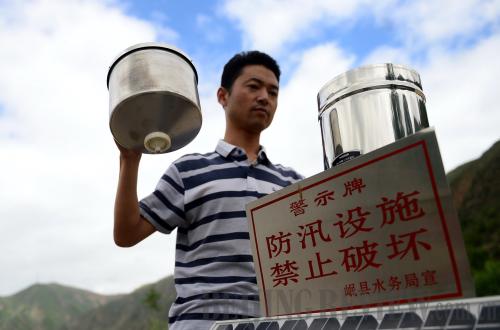|
 |
|
EARLY WARNING SYSTEM: A worker at the Minxian Water Bureau checks an automatic rainfall station at Hadiha Village of Hetuo Township in Minxian County, Gansu Province, on July 20. An early warning and forecasting system was set up in Minxian County after the 6.6-magnitude earthquake hit the area on July 22, 2013. The system covers every village in the region and provides advanced notice of a number of natural disasters (ZHANG MENG) |
Water for Temples
China will invest heavily into providing safe drinking water to all temples around the southwestern Tibet Autonomous Region within 2014, regional authorities announced on July 23.
The one-time investment of 495 million yuan ($79.2 million) will give 1,466 temples access to drinking water, according to the regional water resources department.
About 50,000 people, including monks, nuns, temple staff and nearby residents, will benefit from this project, said Chagxi, a senior official with the department.
The project is intended to end the difficulties Tibetan temples face in sourcing safe water as most of Tibetan Buddhist monasteries are located in mountainous or remote regions.
From 2005-13, China invested 2.22 billion yuan ($352.4 million) in supplying safe drinking water and water for other uses to rural Tibetan residents. To date, more than 86 percent of Tibet's rural areas are served by tap water.
Nursing for the Elderly
Beds in China's nursing centers for the elderly have reached 4.94 million, according to Li Liguo, Minister of Civil Affairs, on July 21.
The number of beds rose nearly 20 percent from the 2012 figure, but there are still only 25 beds for every 1,000 senior citizens, said Li.
The number of people in China at or above the age of 60 had hit 202 million by the end of 2013, making up nearly 15 percent of the total population, according to official data last month.
China's senior population is expected to exceed 300 million in 2025 and hit 30 percent by 2050.
Investment in social services for the elderly has grown quickly in past years, with the number of urban elderly service organizations has topping 70,000, while the rural figure neared 410,000. However, the coverage rate for these groups still lags behind the goals laid out in the 12th Five-Year Plan (2011-15), which stipulated that such services should cover 95 percent and 80 percent of urban and rural areas, respectively, by 2015, said Li.
Arctic Expedition
Scientists onboard the icebreaker Xuelong, literally translating to "Snow Dragon" in English, have begun China's sixth Arctic expedition.
The ship's crew spent about three hours at the first research site in the Bering Sea on July 18. A 200-kg CDT (conductivity, depth and temperature) instrument was put more than 3,000 meters below the surface to survey the sea water.
"During the following 10 days, the team will investigate the chemistry, marine life, geology, hydrology and atmospherics of the area," said Pan Zengdi, chief of the team.
The Bering Sea is one of the key areas for China's Arctic expedition. The team will also explore the Chukchi Sea and the Canada Basin.
Xuelong set off from its Shanghai base on July 11. The vessel, capable of breaking ice 1.2 meters thick, will travel over 11,000 nautical miles during its 76-day voyage. | 